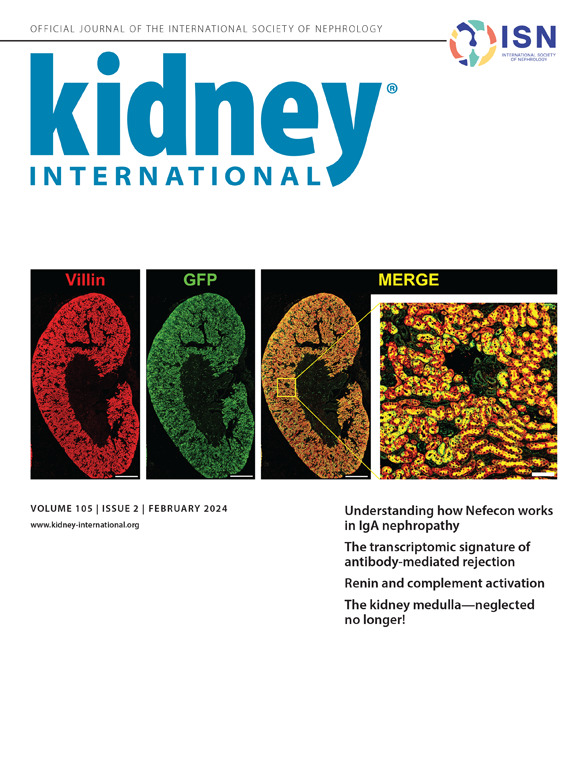Syntaxin 3调节近端小管上皮细胞的顶膜完整性并阻止范可尼综合征的发展。
IF 12.6
1区 医学
Q1 UROLOGY & NEPHROLOGY
引用次数: 0
摘要
上皮细胞极性对包括肾脏在内的各种器官的正常功能至关重要。Syntaxin 3是近端小管上皮细胞(PTECs)的顶膜上的一个关键分子,它是膜与囊泡融合的关键分子。尽管使用除PTECs外的其他类型上皮细胞的体外研究表明syntaxin 3在调节根尖膜完整性方面的作用,但其在体内上皮细胞,特别是PTECs中的功能仍不明确。方法我们分析了新生成的ptec特异性Stx3基因敲除小鼠(Stx3- cko)的肾脏表型,并检测了携带Stx3突变的微绒毛包涵性疾病(MVID)患者的尿液样本。结果stx3 - cko小鼠表现出范可尼综合征的特征,包括尿中磷、葡萄糖、氨基酸和低分子量蛋白质的排泄增加。MVID患者表现出类似的尿路异常。电镜显示,小鼠出现刷状边界萎缩和囊泡运输停滞,运输标记物Rab11和囊泡相关膜蛋白8的根尖下定位增加。关键的转运蛋白和受体,包括钠依赖性磷酸共转运蛋白2a型、钠-葡萄糖共转运蛋白2、一种与中性和碱性氨基酸转运蛋白rBAT相关的蛋白以及meggalin,出现了定位错误和/或表达改变。Syntaxin 3缺乏破坏了ezrin的顶端表达,ezrin是连接肌动蛋白细胞骨架和质膜的关键蛋白。Stx3-cKO小鼠的受体介导和液相内吞作用均受损。结论syntaxin 3在维持PTEC功能和根尖极性中的重要作用,为MVID的肾脏表现和Fanconi综合征的分子机制提供了新的认识。本文章由计算机程序翻译,如有差异,请以英文原文为准。
Syntaxin 3 regulates apical membrane integrity in proximal tubule epithelial cells and prevents Fanconi syndrome development.
INTRODUCTION
Epithelial cell polarity is crucial for the proper functioning of various organs, including the kidneys. Syntaxin 3, a key molecule in membrane-vesicle fusion, is localized in the apical membrane of proximal tubule epithelial cells (PTECs). Although in vitro studies using the other type of epithelial cells besides PTECs have shown the role of syntaxin 3 in regulating apical membrane integrity, its function in epithelial cells in vivo, particularly in PTECs, remains undefined.
METHODS
We analyzed the renal phenotypes of a newly generated PTEC-specific Stx3 knockout mice (Stx3-cKO) and examined urine samples from patients with microvillus inclusion disease (MVID) carrying STX3 mutations.
RESULTS
Stx3-cKO mice exhibited features of Fanconi syndrome, including increased urinary excretion of phosphorus, glucose, amino acids, and low-molecular-weight proteins. Patients with MVID showed similar urinary abnormalities. The mice exhibited brush border atrophy and vesicle transport stagnation, as evidenced by electron microscopy, and increased subapical localization of trafficking markers, Rab11 and vesicle-associated membrane protein 8. Key transporters and receptors including sodium-dependent phosphate cotransporter type 2a, sodium-glucose cotransporter 2, a protein related to the neutral and basic amino acid transport protein rBAT, and megalin showed mislocalization and/or altered expression. Syntaxin 3 deficiency disrupted the apical expression of ezrin, a crucial protein that links the actin cytoskeleton to the plasma membrane. Both receptor-mediated and fluid-phase endocytosis were impaired in Stx3-cKO mice.
CONCLUSIONS
Our results highlight the critical role of syntaxin 3 in maintaining PTEC function and apical polarity, providing new insights into the kidney manifestations of MVID and the molecular mechanisms underlying Fanconi syndrome.
求助全文
通过发布文献求助,成功后即可免费获取论文全文。
去求助
来源期刊

Kidney international
医学-泌尿学与肾脏学
CiteScore
23.30
自引率
3.10%
发文量
490
审稿时长
3-6 weeks
期刊介绍:
Kidney International (KI), the official journal of the International Society of Nephrology, is led by Dr. Pierre Ronco (Paris, France) and stands as one of nephrology's most cited and esteemed publications worldwide.
KI provides exceptional benefits for both readers and authors, featuring highly cited original articles, focused reviews, cutting-edge imaging techniques, and lively discussions on controversial topics.
The journal is dedicated to kidney research, serving researchers, clinical investigators, and practicing nephrologists.
 求助内容:
求助内容: 应助结果提醒方式:
应助结果提醒方式:


